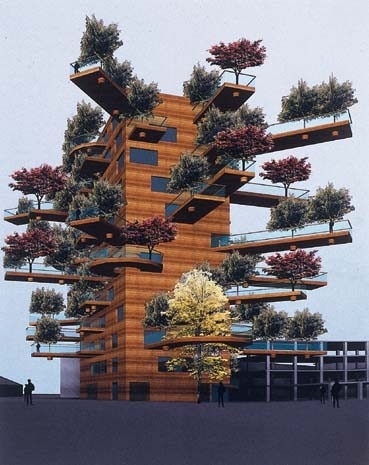The Artificial Landscape: Contemporary Architecture, Urbanism, and Landscape Architecture in the Netherlands, by Hans Ibelings (Editor), NAI Publishers, Rotterdam, 2000 (304 pages, illustrated: 540 b/w and 175 colour, NLG 92.50)
The Netherlands boasts a tradition of modern architecture that treats architectural space as a total experience to be lived and explored aesthetically, physically, psychologically and emotionally. That is, every facet, association, derivation and manifestation of the environment should be subject to investigation. This concern has run from Berlage to the Amsterdam School, De Stijl and the rationalism of Duiker and Oud to the structuralists and the radical rereading of New York City à la Koolhaas. According to the theory of neoplasticism, this all-embracing relationship is a given in every architectural plan, even in designs that do not consciously acknowledge it, for this is how human beings perceive the environment. What does vary from case to case is the quality and the interaction between individuals and architectural space. These factors depend on the calibre of the designs and their capacity to stimulate and constitute milestones.
The Netherlands’ historic legacy of modern architecture is one of the richest and most complex in Europe. The nation always has produced a sizeable amount of theory in the form of journals, manifestos, books and exhibitions, and this blossoming of ideas has fostered singular examples of the marriage of pragmatism and experiment. An integral part of this union is the elevated visual and sensorial quality of many Dutch designs, and not just during the reign of De Stijl, when architecture actually interpreted and represented an avant-garde artistic movement.
Those who read this book, edited by Hans Ibelings, will realize that in the last 15 years the Dutch tradition of questioning a set of established ideas to come up with innovative results has not waned. In reality, it has evolved and been strengthened. The scope of the phenomenon extends far beyond the world-famous projects of Koolhaas, Coenen, van Berkel and MVRDV. The author presents more than 130 works by over 60 firms, and although the book has 300 pages, it is still manageable. Ibelings offers a dense, fast-paced series of short presentations (one scheme per page), capturing the character of the designs and their relationship to external circumstances, including the effects of new technologies, planning advances and changing global economies.
This publication somewhat resembles a CD-ROM (as does its graphic design by Joseph Plateau). It is arranged according to a hierarchy of subject levels that the reader may climb, descend or overlap. The first level contains the principal chapters into which the exposition of the designs is organized, including the blending of nature with artificial landscapes, public housing and other government-subsidised buildings and blueprints for a new Dutch architecture, including unbuilt projects.
Other chapters, each with a brief introduction, are devoted to how traditional Dutch Calvinism relates to fresh, eloquent architectural forms as well as the communications strategy of Dutch architects of the 1990s, who published such a conspicuous number of works that their output surpassed anything in Dutch history. One of the most interesting chapters, entitled ‘Confrontations’, presents multidisciplinary designs that got rave reviews from the critics but were damned by the public.
The second surfing level is represented by several code words (including void, anarchy, management, peep show, wave, corridor, refuge and ocean) selected by Ibelings to categorize the designs. Each of these terms – there are approximately 130 – form a kind of double title page: it suffices to click on one of them to access the third subject level, which includes all the schemes accompanied by short commentary. A separate section contains criticism by a diverse selection of writers, including some critics (Hans van Dijk, Ole Bouman and Janny Rodermond) and architects (Adriaan Geuze, Ben van Berkel and Caroline Bos).
Another striking aspect of recent Dutch architecture that is addressed clearly in this book is the way many architects have taken up what might be called the challenge of normality. Notes Ibelings, ‘The fact that they seek architecture without any symbolic or metaphorical allusions does not signify that there no longer is any absolute meaning. Rather, it means that postmodernism and deconstructivism’s tendency to seek hidden connotations everywhere has been surpassed. Instead, frequently the meanings are derived directly from the appearance of the buildings and, above all, from what one feels and experiences using them’.
Hans Hölger is an architectural critic




